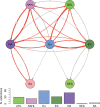Fossil-Informed Models Reveal a Boreotropical Origin and Divergent Evolutionary Trajectories in the Walnut Family (Juglandaceae)
- PMID: 33964165
- PMCID: PMC8677545
- DOI: 10.1093/sysbio/syab030
Fossil-Informed Models Reveal a Boreotropical Origin and Divergent Evolutionary Trajectories in the Walnut Family (Juglandaceae)
Erratum in
-
Corrigendum to: Fossil-Informed Models Reveal a Boreotropical Origin and Divergent Evolutionary Trajectories in the Walnut Family (Juglandaceae).Syst Biol. 2021 Dec 16;71(1):259. doi: 10.1093/sysbio/syab065. Syst Biol. 2021. PMID: 34427686 Free PMC article. No abstract available.
Abstract
Temperate woody plants in the Northern Hemisphere have long been known to exhibit high species richness in East Asia and North America and significantly lower diversity in Europe, but the causes of this pattern remain debated. Here, we quantify the roles of dispersal, niche evolution, and extinction in shaping the geographic diversity of the temperate woody plant family Juglandaceae (walnuts and their relatives). Integrating evidence from molecular, morphological, fossil, and (paleo)environmental data, we find strong support for a Boreotropical origin of the family with contrasting evolutionary trajectories between the temperate subfamily Juglandoideae and the tropical subfamily Engelhardioideae. Juglandoideae rapidly evolved frost tolerance when the global climate shifted to ice-house conditions from the Oligocene, with diversification at high latitudes especially in Europe and Asia during the Miocene. Subsequent range contraction at high latitudes and high levels of extinction in Europe driven by global cooling led to the current regional disparity in species diversity. Engelhardioideae showed temperature conservatism while adapting to increased humidity, tracking tropical climates to low latitudes since the middle Eocene with comparatively little diversification, perhaps due to high competition in the tropical zone. The biogeographic history of Juglandaceae shows that the North Atlantic land bridge and Europe played more critical roles than previously thought in linking the floras of East Asia and North America, and showcases the complex interplay among climate change, niche evolution, dispersal, and extinction that shaped the modern disjunct pattern of species richness in temperate woody plants. [Boreotropical origin; climatic niche evolution; disjunct distribution; dispersal; diversity anomaly; extinction; Juglandaceae.].
© The Author(s) 2021. Published by Oxford University Press, on behalf of the Society of Systematic Biologists.
Figures







Similar articles
-
Whole genome based insights into the phylogeny and evolution of the Juglandaceae.BMC Ecol Evol. 2021 Oct 21;21(1):191. doi: 10.1186/s12862-021-01917-3. BMC Ecol Evol. 2021. PMID: 34674641 Free PMC article.
-
Phylogeny and divergence time estimation of the walnut family (Juglandaceae) based on nuclear RAD-Seq and chloroplast genome data.Mol Phylogenet Evol. 2020 Jun;147:106802. doi: 10.1016/j.ympev.2020.106802. Epub 2020 Mar 23. Mol Phylogenet Evol. 2020. PMID: 32217170
-
The importance of the North Atlantic land bridges and eastern Asia in the post-Boreotropical biogeography of the Northern Hemisphere as revealed from the poison ivy genus (Toxicodendron, Anacardiaceae).Mol Phylogenet Evol. 2019 Oct;139:106561. doi: 10.1016/j.ympev.2019.106561. Epub 2019 Jul 13. Mol Phylogenet Evol. 2019. PMID: 31310817
-
Bird evolution in the Eocene: climate change in Europe and a Danish fossil fauna.Biol Rev Camb Philos Soc. 2006 Nov;81(4):483-99. doi: 10.1017/S146479310600707X. Epub 2006 Aug 8. Biol Rev Camb Philos Soc. 2006. PMID: 16893476 Review.
-
Cenozoic plant diversity of Yunnan: A review.Plant Divers. 2016 Dec 14;38(6):271-282. doi: 10.1016/j.pld.2016.11.004. eCollection 2016 Dec. Plant Divers. 2016. PMID: 30159478 Free PMC article. Review.
Cited by
-
Exploring the Macroevolutionary Signature of Asymmetric Inheritance at Speciation.Syst Biol. 2025 Apr 1;74(2):267-281. doi: 10.1093/sysbio/syae043. Syst Biol. 2025. PMID: 39046782 Free PMC article.
-
Genome Assembly and Winged Fruit Gene Regulation of Chinese Wingnut: Insights from Genomic and Transcriptomic Analyses.Genomics Proteomics Bioinformatics. 2025 Jan 15;22(6):qzae087. doi: 10.1093/gpbjnl/qzae087. Genomics Proteomics Bioinformatics. 2025. PMID: 39666952 Free PMC article.
-
The stepwise rise of angiosperm-dominated terrestrial ecosystems.Biol Rev Camb Philos Soc. 2025 Oct;100(5):2131-2149. doi: 10.1111/brv.70039. Epub 2025 May 30. Biol Rev Camb Philos Soc. 2025. PMID: 40443389 Free PMC article. Review.
-
Genomic Analysis of Plastid-Nuclear Interactions and Differential Evolution Rates in Coevolved Genes across Juglandaceae Species.Genome Biol Evol. 2023 Aug 1;15(8):evad145. doi: 10.1093/gbe/evad145. Genome Biol Evol. 2023. PMID: 37515592 Free PMC article.
-
Fossils indicate marine dispersal in osteoglossid fishes, a classic example of continental vicariance.Proc Biol Sci. 2024 Aug;291(2028):20241293. doi: 10.1098/rspb.2024.1293. Epub 2024 Aug 14. Proc Biol Sci. 2024. PMID: 39137888 Free PMC article.
References
-
- Adrain J.M., Westrop S.R. 2003. Paleobiodiversity: we need new data. Paleobiology 29:22–25.
-
- Aradhya M.K., Potter D., Simon C.J. 2006. Cladistic biogeography of Juglans (Juglandaceae) based on chloroplast DNA intergenic spacer sequences. Darwin’s harvest: new approaches to the origins, evolution and conservation of crops. New York: Columbia University Press. p. 143–170.
-
- Aradhya M.K., Potter D., Gao F., Simon C.J. 2007. Molecular phylogeny of Juglans (Juglandaceae): a biogeographic perspective. Tree Genet. Genomes 3:363–378.
-
- Axelrod D.I. 1983. Biogeography of oaks in the Arcto-Tertiary province. Ann. Mo. Bot. Gard. 70:629–657.
Publication types
MeSH terms
Associated data
LinkOut - more resources
Full Text Sources
Other Literature Sources

